The Samsung 950 Pro PCIe SSD Review (256GB and 512GB)
by Billy Tallis on October 22, 2015 10:55 AM ESTMixed Random Read/Write Performance
Most real-world use consists of a mix of reads and writes, and interleaving the two often poses a particular challenge to drive controllers. This mixed random access test is conducted across a 16GB span of the drive, but on a full drive and with a queue depth of 3.
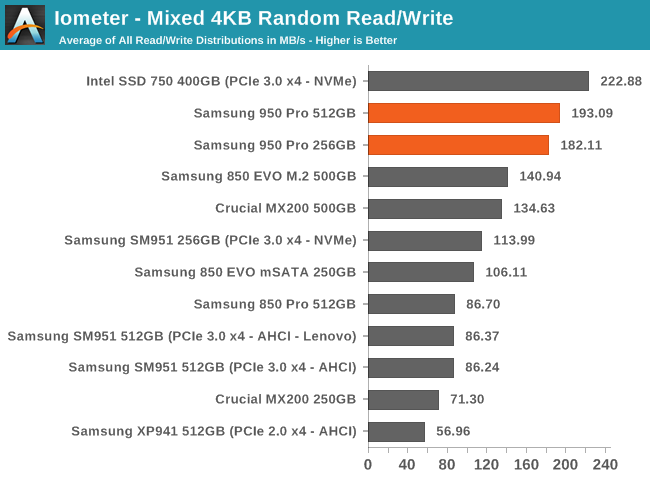
Mixed random access seems much improved over Samsung's earlier M.2 drives, and the 950 Pros fall behind only the Intel SSD 750. The 512GB drive is well behaved here and surpassing the 256GB drive as it should.
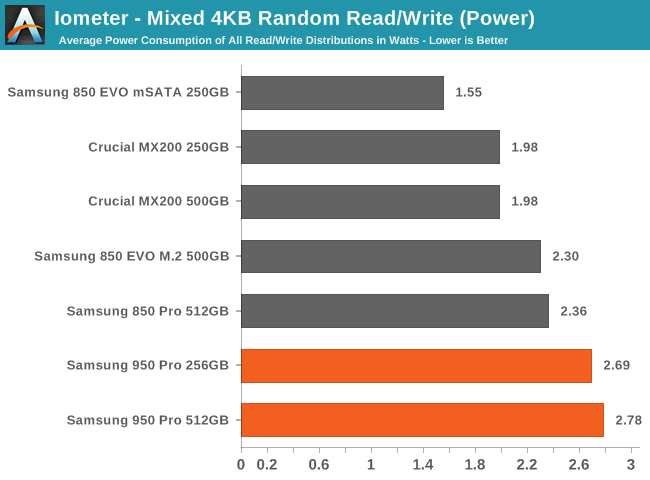
In this case, the higher power consumption of the 950 Pro is very well justified by the higher performance.
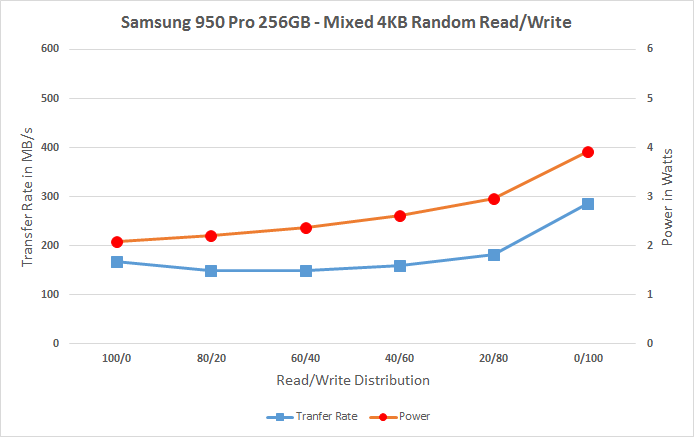 |
|||||||||
There's not much variation across the different workloads. Performance hardly drops during the middle of the test where many controllers have trouble with a balanced mix, but on the other hand the performance at either end of the test is nothing spectacular. Power consumption climbs hand in hand with the proportion of writes, but is accompanied by some increasing in overall data rate.
Mixed Sequential Read/Write Performance
The queue depth of 3 is sufficient for many drives to perform very well at either end of this test, while testing 100% reads or 100% writes. In between, performance typically suffers greatly, and that's where the winners and losers of this test are determined. Anything that's duplicating duplicating or transforming a large amount of data on the drive will produce I/O patterns similar to this test. Creating a System Restore snapshot, backing up files to a different directory on the same drive, and file compression can all produce interleaved reads and writes of large blocks of data, though not necessarily fast enough to be limited by the drive's performance.
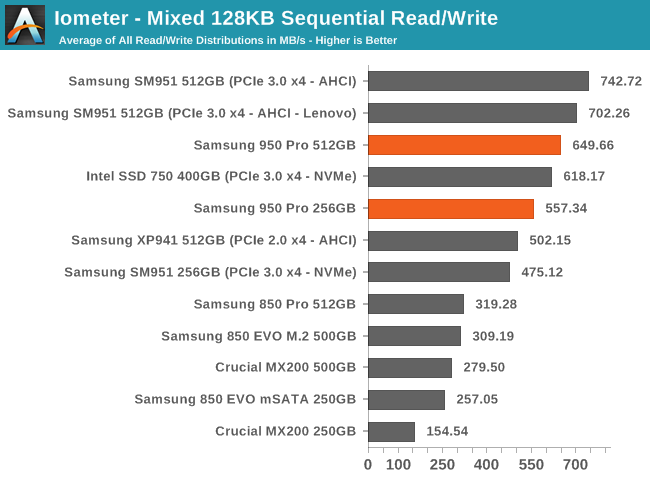
These sequential workloads allow the PCIe drives to stand out and achieve average speeds that would saturate SATA.
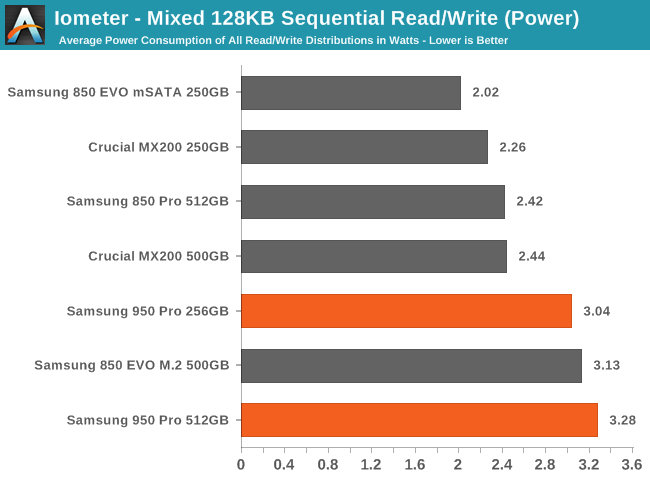
With power consumption in the same neighborhood as the SATA drives, the 950 Pro is significantly more efficient.
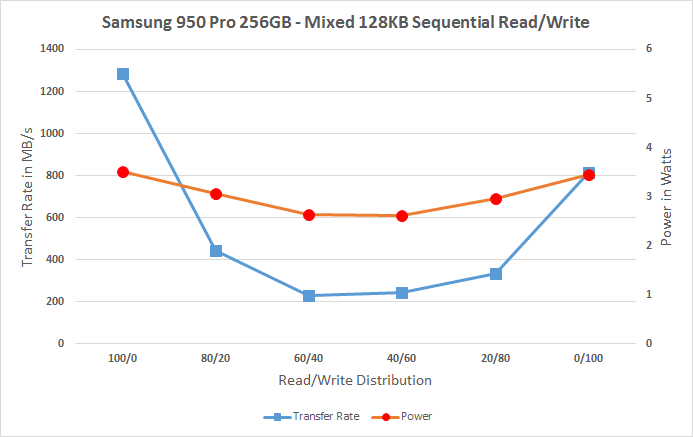 |
|||||||||
Looking at the breakdown by workload, the 950 Pro performs well on the balanced mixes and far outstrips the SATA limit on the very read-heavy workloads and the pure write section at the end of this test.










142 Comments
View All Comments
herbc - Friday, October 23, 2015 - link
How fast do you really need to be happy with using a computer is my question , my computer is faster now than i actually need it to be and all it has is a current SSD .Woff - Friday, October 23, 2015 - link
I have a system with Asus X99 DeLuxe motherboard and a I7-5960X cpu. I use a Samsung 850 EVO 500GB SSD connected to one of the SATA ports, but I want to upgrade this device to a M.2 Samsung 950 Pro. The motherboard offers two ways to connect a M.2 but I don't know witch is the best alternative. The X99 has a on-board M.2 (socket3) but is also delivered with a expansion card, a 'HYPER M.2 x4' card. Anyone who can help me with the best (fastest) solution to my problem?Redstorm - Friday, October 23, 2015 - link
You should be OK to use the Onboard M.2 slot as the manual says "32Gb transfer for the onboard M.2" page 'x' so 4 x PCIe 3.0cjelliott - Tuesday, November 17, 2015 - link
How did you get on with this 950 Pro SSD on the X99 Deluxe? Can you boot from it? I am tempted to buy this SSD but have seen a lot of forums where people are having trouble. I want to install and boot Win 10 Pro from it.l_d_allan - Saturday, October 24, 2015 - link
Hmmmm ... the Samsung Galaxy review was at the top for 5 days, then one day for an ASUS mother board, and only one day for the Surface 4, and now several days for the Samsung PCie SSD.Seems unbalanced. Or just "the luck of the draw"?
Kristian Vättö - Sunday, October 25, 2015 - link
Usually content is only released on weekdays, so reviews that go up later in the week (e.g. on Thursday) may get several days of page time. Oftentimes the content release is dictated by an embargo lift, so the time of publishing isn't on AnandTech's hands.I can assure you that this is just a coincidence - there's no rule or contract that a certain company must get X number of days at the top. Frankly, it wasn't even something we thought about during my time at AnandTech as content always went up when it was ready and free for publishing.
Craig234 - Saturday, October 24, 2015 - link
"The Intel SSD 750 clearly needs to come down in price to be completely sidelined by the 950 Pro. "I think you mean to AVOID being completely...
TheBeagle - Saturday, October 24, 2015 - link
I case anybody is interested, Amazon.com has this lovely items for sale (pre-order) right now. The Amazon web site says the product will be released for sale on Thursday, October 29th. Hurry up before they're all gone - LOL! BeagleFXi - Saturday, October 24, 2015 - link
I know it's not a lot of space but some degree of power loss protection would have been proper for a "pro" device in this price category.Kristian Vättö - Sunday, October 25, 2015 - link
The 950 PRO, just like all Samsung client SSDs, do journaling to protect the FTL against sudden power losses. Protection for cached user data is not really needed since modern file systems have been designed to withstand minor data losses (HDDs also use DRAM to cache writes, so SSDs are no different in that sense).